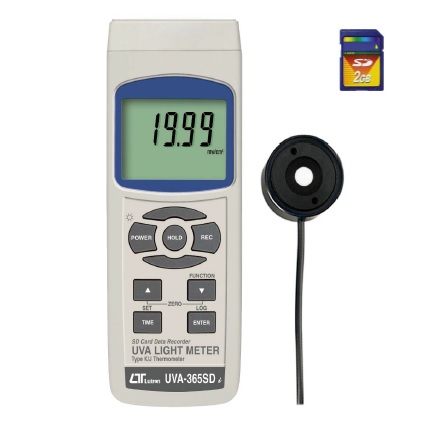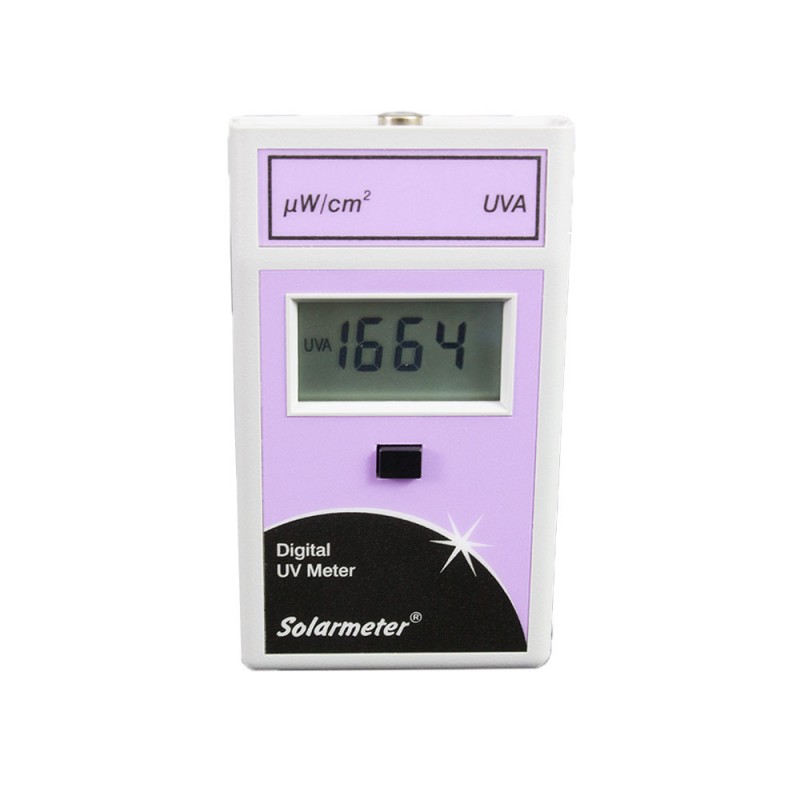เครื่องวัดแสงยูวีเอ/ยูวีบี UVA/UVB

UVA-365SD เครื่องวัดแสงยูวีเอ/ยูวีบี
Specification
- Professional UVA light measurement.
- Long wave 365 nm ultra-violet irradiance measurement.
- Professional UVA light meter, used to measure the UVA irradiation value under the UVA light ( black light ) source.
- Two ranges : 2 mW/cm^2, 20 mW/cm^2.
- Exclusive UVA sensor structure with metallic housing case.
- UVA LSensor with cosine correction filter.
- UVA function build Zero button.
- Application for the UV light measurement : Monitoring blue light radiation hazards in welding, UV sterilization , Graphic arts, Photochemical matching, UV EPROM erasure, Photoresist exposure, Curing of inks, adhesives and coatings.
- Microprocessor circuit provides high reliability and durability.
- Separate UV LIGHT probe allows user to measure the UVA light at an optimum position.
- Type K, Type J thermocouple thermometer.
- Real time SD memory card Datalogger, it Built-in Clock and Calendar, real time data recorder , sampling time set from 1 second to 3600 seconds.
- Manual datalogger is available ( set the sampling time to 0 ), during execute the manual datalogger function, it can set the different position ( location ) No. ( position 1 to position 99 ).
- Innovation and easy operation, computer is not need to setup extra software, after execute datalogger, just take away the SD card from the meter and plug in the SD card into the computer it can down load the all the measured value with the time information ( year/month/date/hour/minute/second ) to the Excel directly, then user can make the further data or graphic analysis by themselves.
- SD card capacity : 1 GB to 16 GB.
- LCD with green light backlight, easy reading.
- Can default auto power off or manual power off.
- Data hold, record max. and min. reading.
- Microcomputer circuit, high accuracy.
- Power by UM3/AA ( 1.5 V ) x 6 batteries or DC 9V adapter.
- RS232/USB PC computer interface.

Solarmeter® Model 4.2 Sensitive UVA Meter
Features:
- Compact, Handheld, and Durable
- Simple Single-Button Operation
- NIST Traceable Accuracy
- LCD Display
- Made In USA
Applications:
- Testing Window Film/Tint Transmission
- Monitoring Low Level UV from Household Lamps
- Testing Ground-level UV from Stadium Lighting
- Measuring Outdoor Shady Area UVA
- Choose Sensitive Model 4.2 For Indoor / Low Intensity Applications
- Choose Standard Model 4.0 For Outdoor / High Intensity Applications
| Radiometer | |
| Model | 4.2 |
| Irradiation Range | 0-1999 µW/cm² UVA |
| Response | 320-400 nm UVA |
| Resolution | 1 µW/cm² |
| Conversion Rate | 3.0 Readings/Sec |
| Display | 3.5 Digit LCD |
| Digit Size | 0.4 (in) / 10.2 (mm) high |
| Operational Temperature | 32°F to 100°F / 0°C to 37.8°C |
| Operational Humidity | 5% to 80% RH |
| Accuracy | ±10% REF.NIST |
| Dimensions |
4.2L x 2.4W x 0.9D (in) / 106.7L x 61W x 22.9D (mm) |
| Weight | 4.5 (oz) / 128 (g) Including Battery |
| Power Source | 9-Volt DC Battery |
| Lens | UV Glass |
| Diffuser | Teflon |
| Agency Approval | CE Mark |
Sensor
The sensor consists of a GaAsP photodiode and a UV filter. It is completely insensitive to visible light longer than 400nm and infrared radiation, because its spectral response only covers the UVA region from 320-400nm.
Operation
To operate your Solarmeter, aim the sensor window located on the top panel of the meter directly at a UV source. Press and hold the push-button switch on the face of the meter. For best results take note of the distance the reading was taken from the UV source in order to ensure repeatable results. Battery operation voltage is viable from 9V down to 6.5V. Below 6.5V, the numbers on the LCD display will begin to dim, indicating the need for battery replacement. Under typical service load, a standard 9V battery will last approximately 2 years.
Proper Usage of Solarmeter® Ultraviolet Radiometer
- To measure home, business, school or car window UV transmission, take reading through window or film and compare to outdoor reading.
- For household lighting, including compact fluorescents, take reading near lamps and increase distance until reading falls below1 W/cm.
- For gym or stadium lighting, take readings at floor level. Ask to have UV shields installed if readings are too high.
- Do not subject the meter to extremes in temperature, humidity, shock or dust.
- Use a dry, soft cloth to clean the instrument. Keep sensor free of oil, dirt, etc.
